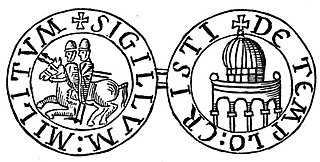
The Poor Fellow-Soldiers of Christ and of the Temple of Solomon, mainly known as the Knights Templar, was a French military order of the Catholic faith, and one of the wealthiest and most popular military orders in Western Christianity. They were founded c. 1119, headquartered on the Temple Mount in Jerusalem, and existed for nearly two centuries during the Middle Ages.
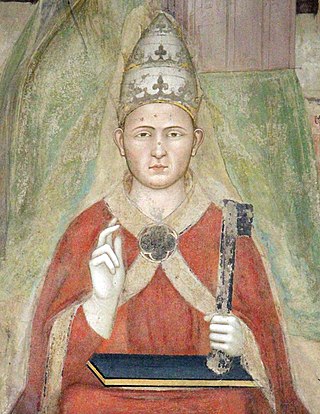
Pope Clement V, born Raymond Bertrand de Got, was head of the Catholic Church and ruler of the Papal States from 5 June 1305 to his death, in April 1314. He is remembered for suppressing the order of the Knights Templar and allowing the execution of many of its members. Clement moved the Papacy from Rome to Avignon, ushering in the period known as the Avignon Papacy.

Year 1291 (MCCXCI) was a common year starting on Monday of the Julian calendar.

Philip IV, called Philip the Fair, was King of France from 1285 to 1314. By virtue of his marriage with Joan I of Navarre, he was also King of Navarre as Philip I from 1284 to 1305, as well as Count of Champagne. Although Philip was known to be handsome, hence the epithet le Bel, his rigid, autocratic, imposing, and inflexible personality gained him other nicknames, such as the Iron King. His fierce opponent Bernard Saisset, bishop of Pamiers, said of him: "He is neither man nor beast. He is a statue."

Jacques de Molay, also spelled "Molai", was the 23rd and last grand master of the Knights Templar, leading the order sometime before 20 April 1292 until it was dissolved by order of Pope Clement V in 1312. Though little is known of his actual life and deeds except for his last years as Grand Master, he is one of the best known Templars.

Guillaume de Nogaret was a French statesman, councilor and keeper of the seal to Philip IV of France.

The siege of Acre took place in 1291 and resulted in the Crusaders' losing control of Acre to the Mamluks. It is considered one of the most important battles of the period. Although the crusading movement continued for several more centuries, the capture of the city marked the end of further crusades to the Levant. When Acre fell, the Crusaders lost their last major stronghold of the Crusader Kingdom of Jerusalem. They still maintained a fortress at the northern city of Tartus, engaged in some coastal raids, and attempted an incursion from the tiny island of Ruad; but, when they lost that, too, in a siege in 1302, the Crusaders no longer controlled any part of the Holy Land.

Thibaud Gaudin was the Grand Master of the Knights Templar from August 1291 until his death in April 1292.

Guillaume de Beaujeu, aka William of Beaujeu was the 21st Grand Master of the Knights Templar, from 1273 until his death during the siege of Acre in 1291. He was the last Grand Master to preside in Palestine.
Templar of Tyre is the conventional designation of the anonymous 14th-century historian who compiled the Old French chronicle known as the Deeds of the Cypriots. The Deeds was written between about 1315 and 1320 on Cyprus and presents a history of the Crusader states and the Kingdom of Cyprus from 1132 down to 1309 as well as an account of the trials of the Templars in 1314. It is divisible into three parts and the third, which is the original work of the compiler, is the most important source for the final years of the Kingdom of Jerusalem and one of only two eyewitness accounts of the fall of Acre in 1291.

Jean de Villiers was the twenty-second grand master of the Knights Hospitaller, serving from 1285 until 1293. He was elected Grand Master after the death of Nicolas Lorgne. De Villiers was Prior of France beginning in 1282 and he remained in France to deal with existing problems of the Order. Jacques de Taxi became Grand Master ad interim, perhaps through 27 June 1286, while awaiting the arrival of the newly elected Grand Master in the Holy Land. De Villiers was present at the Siege of Acre in 1291, but escaped just before the city fell to the Mamluks. He was succeeded by Odon de Pins.
The original historic Knights Templar were a Christian military order, the Order of the Poor Fellow Soldiers of Christ and of the Temple of Solomon, that existed from the 12th to 14th centuries to provide warriors in the Crusades. These men were famous in the high and late Middle Ages, but the Order was disbanded very suddenly by King Philip IV of France, who took action against the Templars in order to avoid repaying his own financial debts. He accused them of heresy, ordered the arrest of all Templars within his realm, put the Order under trial and many of them burned at the stake. The dramatic and rapid end of the Order led to many stories and legends developing about them over the following centuries. The Order and its members increasingly appear in modern fiction, though most of these references portray the medieval organization inaccurately.
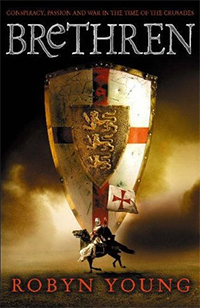
Brethren is a novel written by Robyn Young set in the ninth and last crusade. It was published by Hodder and Stoughton in 2006. It took her seven years to write the novel where she was "intrigued by the idea of these medieval warrior monks".
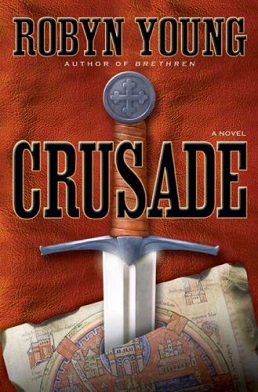
Crusade is a novel by Robyn Young set during the end of the ninth and final crusade. It was first published by Dutton in 2007.

In 1307, members of the Knights Templar in the Kingdom of France were suddenly charged with heresy and arrested after their leader, Master Jacques de Molay, had recently come to France for meetings with Pope Clement V. Many, including their leader, were burned at the stake while others were sentenced to perpetual imprisonment. The events in France led to a series of trials in other locations, not all of which had the same outcome.

The fall of Ruad in 1302 was one of the culminating events of the Crusades in the Eastern Mediterranean. In 1291, the Crusaders had lost their main power base at the coastal city of Acre, and the Muslim Mamluks had been systematically destroying the remaining Crusader ports and fortresses in the region, forcing the Crusaders to relocate the dwindling Kingdom of Jerusalem to the island of Cyprus. In 1299–1300, the Cypriots sought to retake the Syrian port city of Tortosa, by setting up a staging area on Ruad, two miles (3 km) off the coast of Tortosa. The plans were to coordinate an offensive between the forces of the Crusaders, and those of the Ilkhanate. However, though the Crusaders successfully established a bridgehead on the island, the Mongols did not arrive, and the Crusaders were forced to withdraw the bulk of their forces to Cyprus. The Knights Templar set up a permanent garrison on the island in 1300, but the Mamluks besieged and captured Ruad in 1302. With the loss of the island, the Crusaders lost their last foothold in the Holy Land and it marked the end of their presence in the Levant region.

The fall of Outremer describes the history of the Kingdom of Jerusalem from the end of the last European Crusade to the Holy Land in 1272 until the final loss in 1302. The kingdom was the center of Outremer—the four Crusader states—formed after the First Crusade in 1099 and reached its peak in 1187. The loss of Jerusalem in that year began the century-long decline. The years 1272–1302 are fraught with many conflicts throughout the Levant as well as the Mediterranean and Western European regions, and many Crusades were proposed to free the Holy Land from Mamluk control. The major players fighting the Muslims included the kings of England and France, the kingdoms of Cyprus and Sicily, the three Military Orders and Mongol Ilkhanate. Traditionally, the end of Western European presence in the Holy Land is identified as their defeat at the Siege of Acre in 1291, but the Christian forces managed to hold on to the small island fortress of Ruad until 1302.
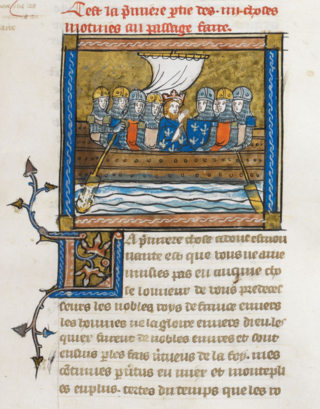
The theme of recovery of the Holy Land was a genre in High–Late Medieval Christian literature about the Crusades. It consisted of treatises and memoranda on how to recover the Holy Land for Christendom, first appearing in preparation for the Second Council of Lyon in 1274. They proliferated following the loss of Acre in 1291, shortly after which the permanent Crusader presence in the Holy Land came to an end, but mostly disappeared with the cancellation of Philip VI of France's planned crusade in 1336 and the start of the Hundred Years' War between England and France the next year. The high point of recovery proposals was the pontificate of Clement V.
Events from the year 1291 in France.














